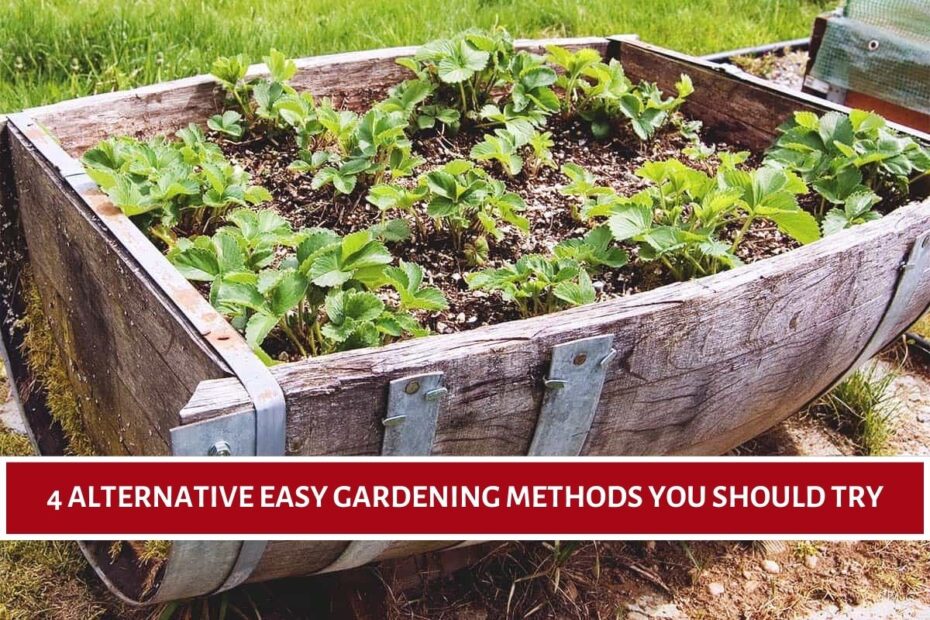4 Alternative Easy Gardening Methods You Should Try:- It’s not necessary to have a lot of room or work hard to garden. There are a number of different ways to garden that are not only easy to use but also have their own benefits for plants.
4 Alternative Easy Gardening Methods You Should Try
Whether you’re new to gardening or just want to make things easier in the garden you already have, these tips will help you grow a lush, useful garden with little work.
1. Container Gardening
If you don’t have a lot of space or the soil isn’t very good, container gardening is a great choice. When you grow plants in pots, you can easily handle the soil’s quality, water them, and move them around to get the most sun.
Containers come in many shapes and sizes, made from clay pots, plastic bins, and even repurposed things like old buckets and wooden crates.
Benefits:
- Flexibility: Containers can be placed on patios, balconies, or windowsills, making them perfect for urban or small-space gardening.
- Control: You can use high-quality soil and tailor the growing conditions for each plant.
- Mobility: Containers can be moved to follow the sun or protect plants from harsh weather conditions.
How to Start: Pick pots that are the right size for the plants you want to grow. Make sure they have drainage holes so they don’t get too wet. Put in good potting mix, put your seeds or seedlings, and water them from time to time. Check for pests and diseases on a regular basis and give extra nutrients if needed.
2. Vertical Gardening
The idea behind vertical gardening is to save room by growing plants up instead of outward. You can use trellises, wall-mounted pots, or vertical garden systems to do this. It works well in small yards or indoors.
Benefits:
- Space Efficiency: Utilizes vertical space, allowing you to grow more plants in a smaller area.
- Aesthetic Appeal: Creates a lush, green wall that can enhance the beauty of any space.
- Ease of Access: Plants at eye level are easier to tend to and harvest.
How to Start: Put up a trellis or other vertical plant structure somewhere that gets a lot of sun. Pick plants that can grow up and down, like tomatoes, growing beans, or herbs that fall over. Use ties or clips to attach your plants to the frame, and make sure they have enough support as they grow. Make sure there is good air flow to keep diseases away.
Also See:- Gardening for Tough Northern and Southern Locations
3. Square Foot Gardening
When you use square foot gardening, you split your garden bed into squares that are each the right size for a different plant. This method is meant to be quick and easy, so it’s simple to keep track of and get the most out of a small area.
Benefits:
- Efficient Use of Space: Planting in a grid layout maximizes the use of available space.
- Ease of Maintenance: Reduces the need for weeding and intensive soil preparation.
- Productive: Ideal for growing a variety of vegetables, herbs, and flowers in a compact area.
How to Start: Either make or buy a raised bed and use string or wooden dividers to make a grid of 1-foot blocks. A good dirt mix should be used to fill the bed. Use the square foot method to plan your plantings. Each square should have a different plant or group of plants. Follow the directions for planting and spacing that come with each crop.
4. Hydroponic Gardening
In hydroponic gardening, plants are grown in a nutrient-rich water solution instead of dirt. This method works very well and can be used indoors or outdoors, so it can be used in a wide range of weather situations.
Benefits:
- Water Efficiency: Uses less water compared to traditional soil gardening, as water is recirculated through the system.
- Faster Growth: Plants often grow faster and produce higher yields due to the direct delivery of nutrients.
- Less Soil-Borne Pests: Reduces the risk of soil-borne diseases and pests.
How to Start: Pick a hydroponic system that works for you, like an aeroponic system, a nutrient film technique (NFT), or a deep water culture (DWC). Follow the manufacturer’s steps to set up the system and make sure there is enough light, air flow, and nutrients. Choose the right plants and keep an eye on their growth. If necessary, change the pH and nutrient levels.
Common Tips for All Methods:
- Monitor Watering Needs: Each method requires different watering practices, so adjust accordingly to keep plants healthy.
- Provide Adequate Light: Ensure your plants receive sufficient light, whether through natural sunlight or artificial grow lights.
- Fertilize Regularly: Plants need nutrients to thrive. Use organic or synthetic fertilizers suited to the specific method and plant types.
- Check for Pests and Diseases: Regularly inspect plants for signs of pests or diseases and take action promptly to prevent issues from spreading.
These different gardening techniques can help you enjoy gardening more and make it easier on yourself. Whether you choose the versatility of container gardening, the efficiency of vertical gardening, the organization of square foot gardening, or the new technology of hydroponics, each method has its own benefits that can make it easy to grow a healthy, productive garden.
